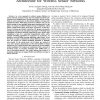Free Online Productivity Tools
i2Speak
i2Symbol
i2OCR
iTex2Img
iWeb2Print
iWeb2Shot
i2Type
iPdf2Split
iPdf2Merge
i2Bopomofo
i2Arabic
i2Style
i2Image
i2PDF
iLatex2Rtf
Sci2ools
135
click to vote
ICDCS
2007
IEEE
2007
IEEE
uSense: A Unified Asymmetric Sensing Coverage Architecture for Wireless Sensor Networks
As a key approach to achieve energy efficiency in sensor networks, sensing coverage has been studied extensively. Researchers have designed many coverage protocols to provide various kinds of service guarantees on the network lifetime, coverage ratio and detection delay. While these protocols are effective, they are not flexible enough to meet multiple design goals simultaneously. In this paper, we propose a Unified Sensing Coverage Architecture, called uSense, which features three novel ideas: Asymmetric Architecture, Generic Switching and Global Scheduling. We propose asymmetric architecture based on the conceptual separation of switching from scheduling. Switching is efficiently supported in sensor nodes, while scheduling is done in a separated computational entity, where multiple scheduling algorithms are supported. As an instance, we propose a two-level global coverage algorithm, called uScan. At the first level, coverage is scheduled to activate different portions of an area. We ...
Asymmetric Architecture | Distributed And Parallel Computing | ICDCS 2007 | Sensing Coverage | Sensor Networks |
Related Content
| Added | 16 Aug 2010 |
| Updated | 16 Aug 2010 |
| Type | Conference |
| Year | 2007 |
| Where | ICDCS |
| Authors | Yu Gu, Joengmin Hwang, Tian He, David Hung-Chang Du |
Comments (0)

